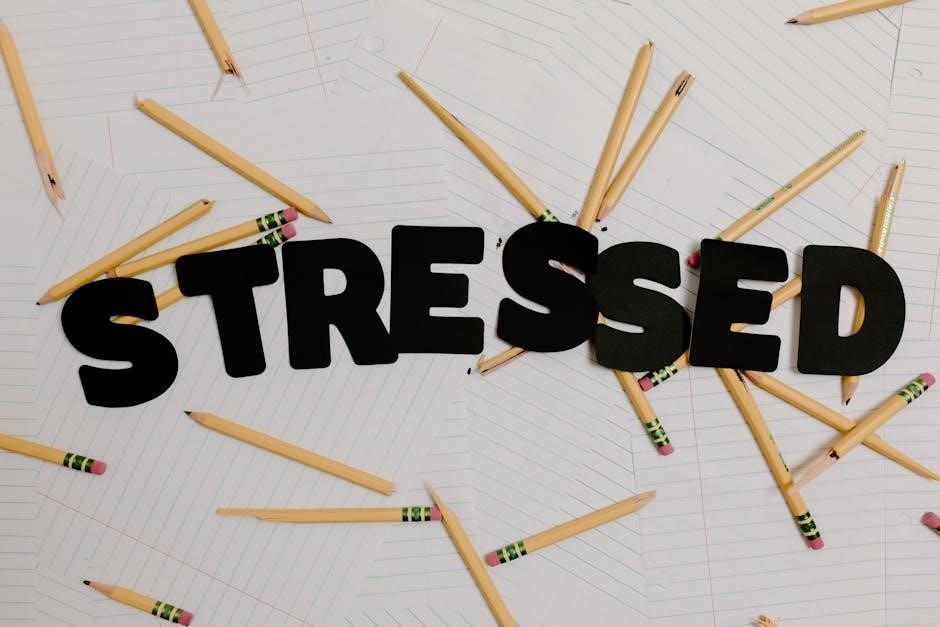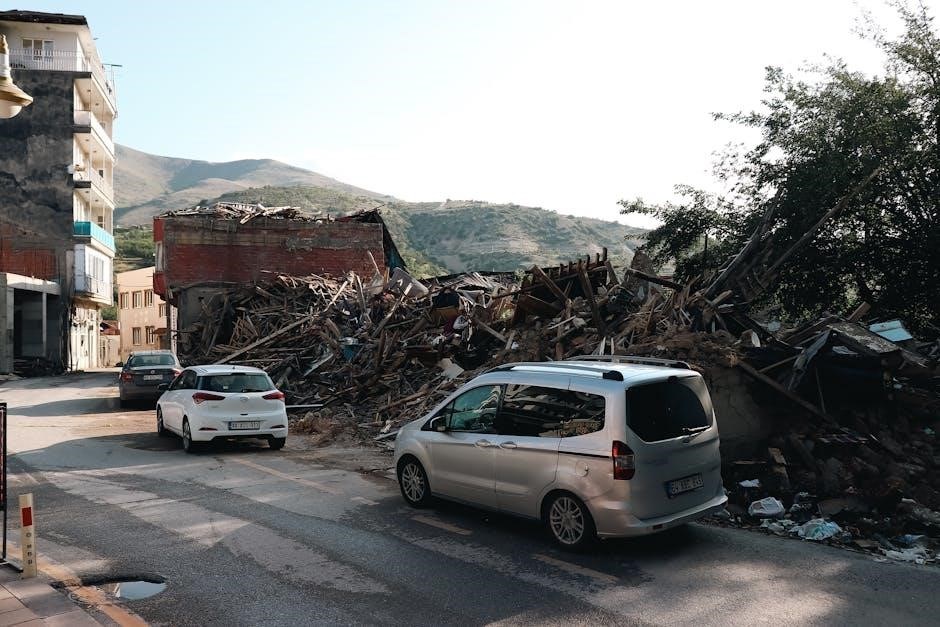Burnout is a state of emotional, physical, and mental exhaustion caused by prolonged stress. A structured recovery plan helps individuals reclaim energy, balance, and well-being through actionable strategies.
1.1 Understanding Burnout and Its Impact
Burnout is a state of emotional, mental, and physical exhaustion caused by prolonged stress, overwork, and lack of balance in life. It can lead to cynicism, reduced productivity, and detachment from activities once enjoyed. If left unaddressed, burnout can severely impact health, relationships, and job performance. Recognizing its signs is crucial for taking the first steps toward recovery and restoring overall well-being.
1.2 The Importance of a Structured Recovery Plan
A structured recovery plan provides clarity and direction, helping individuals regain control over their well-being. It ensures consistency and accountability, making the recovery process more manageable. By setting clear goals and actionable steps, a plan reduces overwhelm and fosters progress. A well-designed plan also prevents burnout relapse by addressing root causes and promoting sustainable habits for long-term health and resilience.

Recognizing Burnout Symptoms
Burnout symptoms include emotional exhaustion, reduced performance, and detachment. Physical signs like fatigue and mental fogginess often accompany feelings of hopelessness. Early recognition is crucial.
2.1 Physical Symptoms of Burnout
Physical symptoms of burnout include chronic fatigue, insomnia, frequent headaches, and muscle pain. Individuals may experience weakened immunity, digestive issues, or changes in appetite and weight. These physical signs often signal prolonged stress and emotional depletion, serving as early warnings to address burnout before it escalates.
2.2 Emotional and Mental Symptoms
Emotional and mental symptoms of burnout include feelings of hopelessness, detachment, and cynicism. Individuals may experience reduced motivation, decreased creativity, and impaired concentration. Anxiety, irritability, and emotional exhaustion are common, leading to a sense of being overwhelmed and unable to cope. These symptoms highlight the need for early intervention to restore mental well-being and emotional resilience.
2.3 Behavioral Indicators of Burnout
Behavioral signs of burnout include procrastination, avoidance of responsibilities, and withdrawal from social interactions. Individuals may exhibit increased absenteeism or presenteeism, and a noticeable decline in productivity. They might also display irritability, mood swings, or a lack of creativity. These behaviors often stem from emotional exhaustion and a sense of hopelessness, making early recognition crucial for addressing burnout effectively and promoting recovery.
Self-Care Strategies for Burnout Recovery
Prioritize rest and sleep, adopt a balanced diet, engage in regular exercise, and practice mindfulness to foster holistic well-being and aid in burnout recovery effectively.
3.1 Prioritizing Rest and Sleep
Establishing a consistent sleep routine is vital for burnout recovery. Aim for 7-9 hours of quality sleep nightly. Create a calming bedtime routine, avoiding screens and stressors. Incorporate short naps if needed, but avoid long ones that disrupt nighttime sleep. A restful environment, such as a cool, dark bedroom, enhances sleep quality. Prioritizing rest helps replenish energy, improve mental clarity, and support overall well-being during the recovery process.
3.2 Nutrition and Gut Health
Nutrition plays a critical role in burnout recovery by replenishing energy and supporting mental health. Focus on whole, nutrient-dense foods like fruits, vegetables, whole grains, and lean proteins. Incorporate omega-3 rich foods for brain health. Stay hydrated and limit processed foods, sugar, and caffeine. A balanced diet helps stabilize mood, reduce inflammation, and restore vitality. Prioritize gut health with probiotics and fiber to enhance mental clarity and overall well-being during recovery.
3.3 The Role of Exercise in Recovery
Exercise is a powerful tool for burnout recovery, reducing stress and improving mood. Physical activity boosts endorphins, combating fatigue and enhancing energy levels. Regular movement, such as walking or yoga, can improve sleep quality and mental clarity. It also provides a healthy distraction, helping to break the cycle of burnout. Consistency is key; even small, manageable routines can foster long-term well-being and resilience.
3.4Mindful Breathing and Relaxation Techniques
3.4 Mindful Breathing and Relaxation Techniques
Mindful breathing and relaxation techniques are essential for calming the mind and body during burnout recovery. Practices like diaphragmatic breathing, meditation, and yoga reduce stress hormones and promote emotional balance. Regular mindfulness exercises enhance focus, reduce anxiety, and improve overall well-being. Incorporating these techniques into daily routines fosters resilience and helps individuals regain control over their mental and physical health, aiding in a sustainable recovery process.

Mental and Emotional Healing
Mental and emotional healing involves restoring psychological well-being through techniques like therapy, mindfulness, and emotional regulation, crucial for effective burnout recovery.
4.1 Practicing Self-Compassion
Practicing self-compassion involves treating yourself with kindness, understanding, and patience during recovery. It helps alleviate guilt and shame, fostering emotional healing. Acknowledge your feelings without judgment, and remind yourself that burnout is a sign of needing care. Engage in affirmations, self-care rituals, and reflective practices to rebuild your mental resilience and embrace your humanity. This mindset is crucial for sustainable recovery and long-term well-being.
4.2 Journaling for Emotional Release
Journaling is a powerful tool for emotional release during burnout recovery. Writing down thoughts and feelings helps process emotions, reduce stress, and gain clarity. Reflecting on experiences identifies patterns and triggers, promoting self-awareness. This practice fosters a safe space to express vulnerability, easing mental burdens and encouraging healing. Regular journaling can also help reframe perspectives, fostering resilience and emotional balance.
4.3 Building a Support Network
Building a support network is crucial for burnout recovery. Surrounding yourself with understanding friends, family, or colleagues can reduce feelings of isolation. Sharing experiences with others fosters emotional connection and practical help. Open communication and mutual respect strengthen these relationships. A support network provides encouragement, helping you stay motivated during recovery. It also offers diverse perspectives, aiding in problem-solving and stress reduction, ultimately promoting healing and preventing future burnout.

Setting Boundaries and Work-Life Balance
Setting boundaries protects personal time, reduces stress, and improves focus. Clearly defining work and personal life helps maintain balance, leading to a more sustainable lifestyle.
5.1 Learning to Say No
Learning to say no is crucial for setting boundaries and preventing overcommitment. It protects personal time and energy, allowing focus on priorities. Saying no doesn’t mean being unhelpful—it’s about safeguarding well-being. Start by politely declining non-essential tasks, offering alternatives when possible. This habit helps maintain a healthier work-life balance and reduces burnout risk. Practice assertive communication to feel empowered in setting limits without guilt or overexplanation.
5.2 Time Management and Prioritization
Effective time management and prioritization are essential for balancing responsibilities and reducing burnout. Start by identifying tasks that align with your goals and delegate or minimize less important activities. Use tools like to-do lists or calendars to organize your day. Focus on high-impact tasks during peak energy hours and break larger projects into manageable steps. This approach helps reduce overwhelm, increases productivity, and fosters a sense of control over your workload.
5.3 Disconnecting from Work-Related Tasks
Disconnecting from work-related tasks is crucial for burnout recovery. Set clear boundaries by designating specific work hours and avoiding work-related activities outside these times. Turn off notifications, create a dedicated workspace, and mentally detach from work responsibilities after hours. This helps recharge energy, reduce stress, and promote a healthier work-life balance, fostering long-term well-being and productivity.

Social Support and Community
Social support is vital for burnout recovery, offering emotional and practical help from friends, family, and colleagues. Building a strong community fosters belonging and shared experiences, reducing isolation and enhancing resilience.
6.1 The Role of Friends and Family
Friends and family play a crucial role in burnout recovery by offering emotional support and practical assistance. Their understanding and encouragement create a safe space for healing. Sharing struggles with loved ones fosters connection and reduces feelings of isolation. They can also help with daily tasks, allowing time for rest and self-care. Having a strong support system at home accelerates recovery and helps rebuild energy and motivation.
6.2 Joining Support Groups
Joining support groups connects individuals with others experiencing similar challenges, fostering a sense of community and understanding. Sharing experiences and advice within these groups reduces feelings of isolation and provides practical solutions. Support groups also offer encouragement and accountability, helping individuals stay motivated throughout their recovery journey; They serve as a valuable resource for learning coping strategies and gaining perspectives from others who have navigated burnout successfully.
6.3 Professional Coaching or Therapy
Professional coaching or therapy provides personalized guidance to address burnout’s root causes. Trained experts offer evidence-based strategies, helping individuals develop coping mechanisms and improve mental well-being. Through structured sessions, professionals facilitate reflection, goal-setting, and sustainable lifestyle changes. Therapy also enhances self-awareness, enabling individuals to identify triggers and build resilience. It offers a safe space for emotional expression and tailored support, fostering long-term recovery and personal growth.
Practical Tools for Recovery
Utilize tools like journals, apps, and planners to track progress, implement habits, and maintain accountability, ensuring a structured approach to burnout recovery.
7.1 Burnout Recovery Checklists

Burnout recovery checklists provide structured guidance, helping individuals track progress and stay accountable. They break down recovery into manageable steps, such as daily habits, self-care rituals, and work boundaries. These tools ensure consistency, offering a clear roadmap for rebuilding energy and motivation. By prioritizing actionable items, checklists make the recovery process less overwhelming, fostering a sense of control and progress.
7.2 Action Plans for Daily Habits
Action plans for daily habits help individuals establish consistent routines that promote recovery. By breaking tasks into small, manageable steps, these plans foster accountability and progress. Incorporating activities like mindfulness, exercise, and downtime ensures a balanced approach. Tailoring the plan to personal needs and priorities creates a roadmap for sustainable change, helping to rebuild energy and resilience over time.
7.3 Tracking Progress and Celebrating Milestones
Tracking progress in burnout recovery helps maintain motivation and accountability. Regularly monitoring daily habits and achievements ensures consistency. Celebrating milestones, no matter how small, reinforces positive behaviors and builds confidence. Acknowledging successes, whether through journaling or sharing with a support network, fosters a sense of accomplishment and keeps the recovery journey engaging and rewarding over time.

Creating a Personalized Recovery Plan
Creating a personalized recovery plan involves assessing individual needs and setting realistic goals. Incorporating hobbies and interests ensures a tailored and sustainable approach to healing.
8.1 Assessing Individual Needs
Assessing individual needs is the foundation of a personalized recovery plan. Evaluate physical symptoms, mental state, and emotional well-being to identify specific areas requiring attention. Consider lifestyle habits, such as work-life balance, social connections, and self-care routines. Reflect on personal values and goals to align the recovery process with what matters most. This step ensures the plan addresses unique challenges and fosters a tailored approach to healing and growth.
8.2 Setting Realistic and Achievable Goals
Setting realistic and achievable goals is crucial for a successful burnout recovery plan. Break down larger objectives into smaller, manageable steps to avoid overwhelm. Use the SMART framework—Specific, Measurable, Achievable, Relevant, and Time-bound—to create clear milestones. Celebrate progress, no matter how small, to build confidence and maintain motivation. This approach ensures steady growth and helps sustain energy and focus throughout the recovery journey.
8.3 Incorporating Hobbies and Interests
Incorporating hobbies and interests into your burnout recovery plan helps reignite passion and joy. Engage in activities that bring fulfillment, whether creative, physical, or social. These pursuits provide mental breaks, reducing stress and fostering balance. Experiment with new hobbies or revisit old ones to discover what resonates with you. Make time for these activities, as they enrich your life and support overall well-being during recovery.

Reflecting on Burnout Causes
Reflecting on burnout causes involves identifying triggers and patterns. Self-reflection helps uncover root issues, enabling targeted solutions for prevention and sustainable change.
9.1 Identifying Triggers
Identifying triggers involves pinpointing specific factors contributing to burnout, such as excessive workload, lack of control, or poor work-life balance. Self-reflection and analysis help uncover these root causes, enabling targeted interventions. Recognizing patterns in emotions, behaviors, and environmental factors is crucial for addressing burnout effectively. Understanding these triggers is the first step toward developing a tailored recovery plan and preventing future episodes. Awareness fosters sustainable change.
9.2 Analyzing Work and Life Patterns
Analyzing work and life patterns involves examining routines, habits, and time distribution to identify imbalances contributing to burnout. This step helps uncover unsustainable practices, such as overcommitment or lack of personal time. By assessing these patterns, individuals can pinpoint areas requiring adjustment to create a more balanced lifestyle. This analysis is crucial for tailoring recovery strategies and preventing future burnout episodes. It promotes awareness and sustainable change.
9.3 Avoiding Future Burnout
Avoiding future burnout requires proactive strategies, such as setting clear boundaries, prioritizing self-care, and maintaining a sustainable work-life balance. Regularly assessing stress levels and addressing triggers early can prevent relapse. Cultivating resilience, seeking support, and adopting a growth mindset are key. By implementing these practices, individuals can reduce the risk of burnout and create a healthier, more balanced lifestyle moving forward. Consistency is essential for long-term well-being.

Lifestyle Changes for Long-Term Recovery
Lifestyle changes are essential for sustainable burnout recovery. Simplifying life, reducing consumerism, and adopting resilient habits foster long-term well-being. These changes promote a balanced, healthy lifestyle.
10.1 Reducing Consumerism and Simplifying Life
Reducing consumerism and simplifying life can alleviate burnout by minimizing stress and financial pressure. Decluttering living spaces and adopting minimalist habits help create a sense of control. Prioritizing essential spending and embracing gratitude reduce the urge for excessive consumption. A simpler lifestyle fosters clarity, lowers expenses, and promotes emotional well-being, allowing individuals to focus on what truly matters.
10.2 Building Resilience
Building resilience is crucial for long-term burnout recovery. It involves developing coping skills, emotional strength, and adaptability to handle stress. Practices like mindfulness, cognitive reframing, and self-care foster resilience. By enhancing mental and emotional flexibility, individuals can better navigate challenges and recover more effectively. Regular practice strengthens resilience, enabling sustained well-being and reducing the risk of future burnout.
10.3 Embracing a Growth Mindset
Embracing a growth mindset is essential for burnout recovery. It involves believing abilities and intelligence can grow through effort and learning. This mindset fosters adaptability, resilience, and motivation to overcome challenges. By viewing burnout as an opportunity for growth, individuals can transform setbacks into stepping stones for renewal and long-term well-being. Cultivating a growth mindset enhances self-awareness, problem-solving, and energy renewal, paving the way for sustainable recovery.

Preventing Burnout Relapse
Preventing burnout relapse requires continuous self-care, sustainable habits, and proactive stress monitoring; Early intervention and seeking support are key to maintaining long-term well-being and resilience.
11.1 Continuous Self-Care Practices
Continuous self-care is essential to prevent burnout relapse. Incorporate daily habits like mindfulness, meditation, and physical activity to maintain mental and emotional balance. Prioritize activities that bring joy and fulfillment, ensuring time for relaxation and connection with loved ones. Consistency in self-care routines helps build resilience and reduces the risk of burnout recurrence, fostering long-term well-being and energy sustainability.
11.2 Regular Mental Health Check-Ins
Regular mental health check-ins are vital for sustaining recovery. Schedule time for self-reflection, journaling, or therapy to monitor emotional well-being. These practices help identify early signs of stress or burnout, enabling prompt interventions. Consistent check-ins foster emotional resilience, reduce anxiety, and promote a balanced mindset. By prioritizing mental health, individuals can address challenges before they escalate, ensuring ongoing growth and well-being.
11.3 Establishing a Sustainable Routine
Establishing a sustainable routine is crucial for long-term burnout recovery. Consistency helps rebuild energy levels and reduces stress. Incorporate activities like regular meals, exercise, and downtime to create balance. Flexibility is key, allowing adjustments as needed. A well-structured routine fosters productivity and relaxation, preventing burnout relapse. Prioritize tasks, set realistic goals, and allocate time for hobbies to maintain mental and physical well-being.
Overcoming burnout requires intentional effort and sustained commitment. By implementing the strategies outlined in this guide, individuals can restore balance and achieve lasting well-being. Stay proactive and prioritize self-care to prevent future burnout and maintain a healthy, fulfilling life.
12.1 Recap of Key Recovery Strategies
Effective burnout recovery involves a combination of self-care practices, emotional healing, and boundary-setting. Prioritize rest, nutrition, and exercise to replenish physical health. Engage in mindfulness, journaling, and seek support to address mental and emotional exhaustion. Establish clear boundaries, manage time effectively, and disconnect from work-related tasks. Incorporate hobbies and reflect on triggers to avoid future burnout. Celebrate progress and maintain a sustainable routine for long-term well-being.
12.2 Encouragement for Ongoing Growth
Embrace your recovery journey with resilience and self-compassion. Celebrate small victories and recognize the strength in every step forward. Growth is a lifelong process, and sustaining progress requires patience and kindness toward yourself. Continue nurturing your mental, emotional, and physical well-being. Remember, recovery is not a destination but a journey—one that fosters renewal, purpose, and long-term fulfillment. Keep moving forward with courage and hope.




